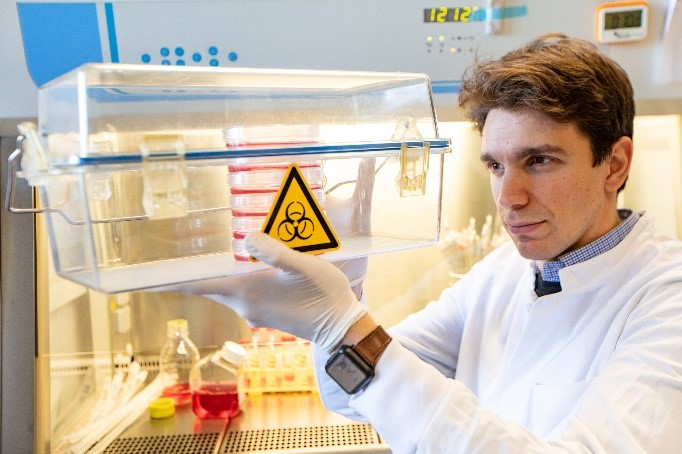Rapid therapeutic approaches for viral diseases
Joint research team from Fraunhofer ITEM and Hannover Medical School successful in Europe-wide SPRIND challenge with a new development pipeline for RNA-based drugs
Viruses are a major problem for human health worldwide – and this has not only been the case since the outbreak of the SARS-CoV-2 pandemic. Despite successful vaccine development, there are still no effective drugs available against most viral diseases – a situation that should be changed as quickly as possible. In the iGUARD (integrated Guided Ultrafast Antiviral RNAi Drug development) project, a team of researchers at the Fraunhofer Institute for Toxicology and Experimental Medicine ITEM headed by Prof. Armin Braun will collaborate with Prof. Axel Schambach, head of the Institute for Experimental Hematology at the Hannover Medical School (MHH), to develop RNA-based active substances targeting viral diseases that can be adapted particularly quickly to different viruses and can thus provide protection against emerging infectious diseases. Together with eight other projects, this project was selected from 45 applicants in a Europe-wide research competition and is now being funded by the German Federal Agency for Disruptive Innovation (SPRIND), initially with 700,000 euros for one year.
Blocking virus replication
The research team is focusing on the parainfluenza virus, which attacks the lower respiratory tract and triggers flu-like symptoms, especially in children and people with weakened immune systems. The goal is to prevent the virus from multiplying and spreading in the body. The team of researchers hopes to achieve this with the help of so-called RNA interference (RNAi). RNAi uses a natural mechanism in the cell to specifically switch off the assembly instructions for individual proteins – so-called messenger RNAs (mRNAs). The RNAi system can, however, also be used to block foreign mRNAs. In the event of a viral infection, the body builds short RNA snippets that bind to the appropriate mRNA site, like a Lego brick, thereby rendering it unreadable and triggering its degradation. As a result, the genetic blueprint it contains is not implemented and virus replication is thus blocked. “We want to use this mechanism to develop suitable RNAi building blocks that specifically paralyze sections of the parainfluenza virus genome,” explains Philippe Vollmer Barbosa, research associate at the MHH Institute of Experimental Hematology and at the Fraunhofer ITEM Division of Preclinical Pharmacology and Toxicology.
Development process of a drug candidate reduced to a few weeks
“The RNAi technology uses molecular methods to target the Achilles’ heel of viruses, so to speak,” says Prof. Schambach. The team of researchers uses artificial intelligence to identify suitable RNAi candidates. What is known as in-silico design is aimed at detecting suitable virus target structures from gene databases and selecting suitable targets for RNAi. “We are mainly looking for so-called conserved regions that are indispensable for the virus and are therefore unlikely to change, so that no resistance can develop,” the scientist notes. Such a search usually takes several months, sometimes even years. With the help of a development pipeline designed by the researchers, the entire process is now supposed be shortened to eight weeks.

By gene taxi into the target cell
The RNA therapeutic agent is not intended to be administered by injection or as a tablet, but by inhalation to take it directly to the lower respiratory tract with as few side effects as possible. A harmless viral vector will act as a gene taxi to ensure that the therapeutic RNA is delivered directly to the target cells in the lung affected by the virus. The efficacy of the drug will be tested in human lung tissue sections as well as in 3D cell cultures from human lung epithelium. “If all this works out, we will be able to use our iGUARD platform to design appropriate therapeutics for other virus types as well and also to adapt the active ingredients quickly to emerging viral diseases,” Prof. Braun is convinced. Drugs for lung diseases such as fibrosis, asthma or lung cancer could also be developed in this way.
The iGUARD project is a cooperation between the MHH Institute for Experimental Hematology (Prof. Axel Schambach), the MHH Clinic for Hematology, Hemostaseology, Oncology and Stem Cell Transplantation (Dr. Adrian Schwarzer) and the Fraunhofer ITEM Division of Preclinical Pharmacology and Toxicology (Prof. Armin Braun). At the end of the first year, the team can apply for a second round of funding.
 Fraunhofer Institute for Toxicology and Experimental Medicine
Fraunhofer Institute for Toxicology and Experimental Medicine